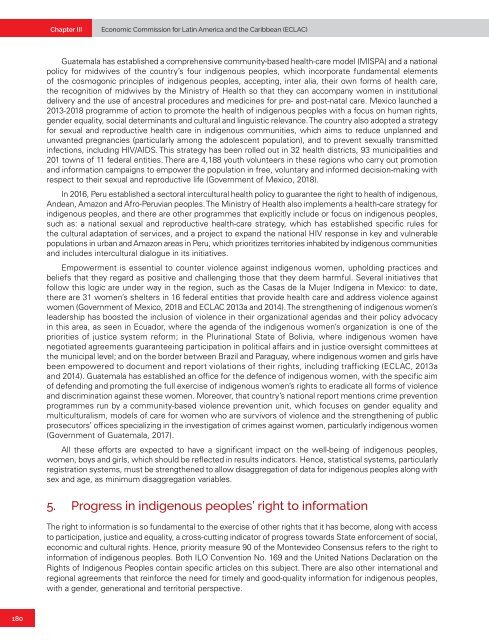Draft first regional report on the implementation of the Montevideo Consensus on Population and Development
This draft report seeks to give an account of progress in the implementation of the priority measures of the Montevideo Consensus on Population and Development in the region, as well as the differences between countries in terms of the degree of implementation. By highlighting relevant national experiences, it also seeks to facilitate the exchange of good practices among countries so that they can benefit from each other in their efforts to advance the implementation of the actions of the Montevideo Consensus.
This draft report seeks to give an account of progress in the implementation of the priority measures of the Montevideo Consensus on Population and Development in the region, as well as the differences between countries in terms of the degree of implementation. By highlighting relevant national experiences, it also seeks to facilitate the exchange of good practices among countries so that they can benefit from each other in their efforts to advance the implementation of the actions of the Montevideo Consensus.
You also want an ePaper? Increase the reach of your titles
YUMPU automatically turns print PDFs into web optimized ePapers that Google loves.
Chapter III<br />
Ec<strong>on</strong>omic Commissi<strong>on</strong> for Latin America <strong>and</strong> <strong>the</strong> Caribbean (ECLAC)<br />
Guatemala has established a comprehensive community-based health-care model (MISPA) <strong>and</strong> a nati<strong>on</strong>al<br />
policy for midwives <strong>of</strong> <strong>the</strong> country’s four indigenous peoples, which incorporate fundamental elements<br />
<strong>of</strong> <strong>the</strong> cosmog<strong>on</strong>ic principles <strong>of</strong> indigenous peoples, accepting, inter alia, <strong>the</strong>ir own forms <strong>of</strong> health care,<br />
<strong>the</strong> recogniti<strong>on</strong> <strong>of</strong> midwives by <strong>the</strong> Ministry <strong>of</strong> Health so that <strong>the</strong>y can accompany women in instituti<strong>on</strong>al<br />
delivery <strong>and</strong> <strong>the</strong> use <strong>of</strong> ancestral procedures <strong>and</strong> medicines for pre- <strong>and</strong> post-natal care. Mexico launched a<br />
2013-2018 programme <strong>of</strong> acti<strong>on</strong> to promote <strong>the</strong> health <strong>of</strong> indigenous peoples with a focus <strong>on</strong> human rights,<br />
gender equality, social determinants <strong>and</strong> cultural <strong>and</strong> linguistic relevance. The country also adopted a strategy<br />
for sexual <strong>and</strong> reproductive health care in indigenous communities, which aims to reduce unplanned <strong>and</strong><br />
unwanted pregnancies (particularly am<strong>on</strong>g <strong>the</strong> adolescent populati<strong>on</strong>), <strong>and</strong> to prevent sexually transmitted<br />
infecti<strong>on</strong>s, including HIV/AIDS. This strategy has been rolled out in 32 health districts, 93 municipalities <strong>and</strong><br />
201 towns <strong>of</strong> 11 federal entities. There are 4,188 youth volunteers in <strong>the</strong>se regi<strong>on</strong>s who carry out promoti<strong>on</strong><br />
<strong>and</strong> informati<strong>on</strong> campaigns to empower <strong>the</strong> populati<strong>on</strong> in free, voluntary <strong>and</strong> informed decisi<strong>on</strong>-making with<br />
respect to <strong>the</strong>ir sexual <strong>and</strong> reproductive life (Government <strong>of</strong> Mexico, 2018).<br />
In 2016, Peru established a sectoral intercultural health policy to guarantee <strong>the</strong> right to health <strong>of</strong> indigenous,<br />
Andean, Amaz<strong>on</strong> <strong>and</strong> Afro-Peruvian peoples. The Ministry <strong>of</strong> Health also implements a health-care strategy for<br />
indigenous peoples, <strong>and</strong> <strong>the</strong>re are o<strong>the</strong>r programmes that explicitly include or focus <strong>on</strong> indigenous peoples,<br />
such as: a nati<strong>on</strong>al sexual <strong>and</strong> reproductive health-care strategy, which has established specific rules for<br />
<strong>the</strong> cultural adaptati<strong>on</strong> <strong>of</strong> services, <strong>and</strong> a project to exp<strong>and</strong> <strong>the</strong> nati<strong>on</strong>al HIV resp<strong>on</strong>se in key <strong>and</strong> vulnerable<br />
populati<strong>on</strong>s in urban <strong>and</strong> Amaz<strong>on</strong> areas in Peru, which prioritizes territories inhabited by indigenous communities<br />
<strong>and</strong> includes intercultural dialogue in its initiatives.<br />
Empowerment is essential to counter violence against indigenous women, upholding practices <strong>and</strong><br />
beliefs that <strong>the</strong>y regard as positive <strong>and</strong> challenging those that <strong>the</strong>y deem harmful. Several initiatives that<br />
follow this logic are under way in <strong>the</strong> regi<strong>on</strong>, such as <strong>the</strong> Casas de la Mujer Indígena in Mexico: to date,<br />
<strong>the</strong>re are 31 women’s shelters in 16 federal entities that provide health care <strong>and</strong> address violence against<br />
women (Government <strong>of</strong> Mexico, 2018 <strong>and</strong> ECLAC 2013a <strong>and</strong> 2014). The streng<strong>the</strong>ning <strong>of</strong> indigenous women’s<br />
leadership has boosted <strong>the</strong> inclusi<strong>on</strong> <strong>of</strong> violence in <strong>the</strong>ir organizati<strong>on</strong>al agendas <strong>and</strong> <strong>the</strong>ir policy advocacy<br />
in this area, as seen in Ecuador, where <strong>the</strong> agenda <strong>of</strong> <strong>the</strong> indigenous women’s organizati<strong>on</strong> is <strong>on</strong>e <strong>of</strong> <strong>the</strong><br />
priorities <strong>of</strong> justice system reform; in <strong>the</strong> Plurinati<strong>on</strong>al State <strong>of</strong> Bolivia, where indigenous women have<br />
negotiated agreements guaranteeing participati<strong>on</strong> in political affairs <strong>and</strong> in justice oversight committees at<br />
<strong>the</strong> municipal level; <strong>and</strong> <strong>on</strong> <strong>the</strong> border between Brazil <strong>and</strong> Paraguay, where indigenous women <strong>and</strong> girls have<br />
been empowered to document <strong>and</strong> <str<strong>on</strong>g>report</str<strong>on</strong>g> violati<strong>on</strong>s <strong>of</strong> <strong>the</strong>ir rights, including trafficking (ECLAC, 2013a<br />
<strong>and</strong> 2014). Guatemala has established an <strong>of</strong>fice for <strong>the</strong> defence <strong>of</strong> indigenous women, with <strong>the</strong> specific aim<br />
<strong>of</strong> defending <strong>and</strong> promoting <strong>the</strong> full exercise <strong>of</strong> indigenous women’s rights to eradicate all forms <strong>of</strong> violence<br />
<strong>and</strong> discriminati<strong>on</strong> against <strong>the</strong>se women. Moreover, that country’s nati<strong>on</strong>al <str<strong>on</strong>g>report</str<strong>on</strong>g> menti<strong>on</strong>s crime preventi<strong>on</strong><br />
programmes run by a community-based violence preventi<strong>on</strong> unit, which focuses <strong>on</strong> gender equality <strong>and</strong><br />
multiculturalism, models <strong>of</strong> care for women who are survivors <strong>of</strong> violence <strong>and</strong> <strong>the</strong> streng<strong>the</strong>ning <strong>of</strong> public<br />
prosecutors’ <strong>of</strong>fices specializing in <strong>the</strong> investigati<strong>on</strong> <strong>of</strong> crimes against women, particularly indigenous women<br />
(Government <strong>of</strong> Guatemala, 2017).<br />
All <strong>the</strong>se efforts are expected to have a significant impact <strong>on</strong> <strong>the</strong> well-being <strong>of</strong> indigenous peoples,<br />
women, boys <strong>and</strong> girls, which should be reflected in results indicators. Hence, statistical systems, particularly<br />
registrati<strong>on</strong> systems, must be streng<strong>the</strong>ned to allow disaggregati<strong>on</strong> <strong>of</strong> data for indigenous peoples al<strong>on</strong>g with<br />
sex <strong>and</strong> age, as minimum disaggregati<strong>on</strong> variables.<br />
5. Progress in indigenous peoples’ right to informati<strong>on</strong><br />
The right to informati<strong>on</strong> is so fundamental to <strong>the</strong> exercise <strong>of</strong> o<strong>the</strong>r rights that it has become, al<strong>on</strong>g with access<br />
to participati<strong>on</strong>, justice <strong>and</strong> equality, a cross-cutting indicator <strong>of</strong> progress towards State enforcement <strong>of</strong> social,<br />
ec<strong>on</strong>omic <strong>and</strong> cultural rights. Hence, priority measure 90 <strong>of</strong> <strong>the</strong> M<strong>on</strong>tevideo C<strong>on</strong>sensus refers to <strong>the</strong> right to<br />
informati<strong>on</strong> <strong>of</strong> indigenous peoples. Both ILO C<strong>on</strong>venti<strong>on</strong> No. 169 <strong>and</strong> <strong>the</strong> United Nati<strong>on</strong>s Declarati<strong>on</strong> <strong>on</strong> <strong>the</strong><br />
Rights <strong>of</strong> Indigenous Peoples c<strong>on</strong>tain specific articles <strong>on</strong> this subject. There are also o<strong>the</strong>r internati<strong>on</strong>al <strong>and</strong><br />
<str<strong>on</strong>g>regi<strong>on</strong>al</str<strong>on</strong>g> agreements that reinforce <strong>the</strong> need for timely <strong>and</strong> good-quality informati<strong>on</strong> for indigenous peoples,<br />
with a gender, generati<strong>on</strong>al <strong>and</strong> territorial perspective.<br />
180


















